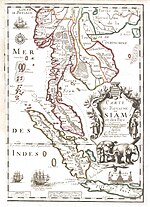Lavo Kingdom
Kingdom of Lavo | |||||||||||
|---|---|---|---|---|---|---|---|---|---|---|---|
| the 7th century–1388 | |||||||||||
| Capital | Lavo (until 1087) Ayodhaya (1087 - 1388) | ||||||||||
| Common languages | Mon language | ||||||||||
| Religion | Theravada Buddhism, later Hinduism and Mahayana Buddhism | ||||||||||
| Government | Monarchy | ||||||||||
| Historical era | Middle Ages | ||||||||||
• Formation | the 7th century | ||||||||||
• Annexxed into Ayutthaya kingdom | 1388 | ||||||||||
| |||||||||||
The Kingdom of Lavo was a political entity on the left bank of the Chao Phraya River in the Upper Chao Phraya valley from the end of Dvaravati civilization, around the 7th century, until 1388. The original center of Lavo civilization was Lavo itself, or modern Lopburi, but the capital shifted southward to Ayodhaya around 11th century, where it remained and became the Ayutthaya kingdom, according to recent historical analysis.
History
| History of Thailand |
|---|
 |
|
|
The legendary first king of Lavo, Phraya Kalavarnadit, was said to have established the city around 450 AD[1] as one of the Dvaravati city-states. Kalavarnadit established a new era called the Chulasakaraj, which was the era used by the Siamese and the Burmese until 19th century.
Isanavarman I of Chenla expanded Khmer influence to the Chao Phraya valley through his campaigns around the 7th century[2]. Dvaravati cities that fell under Khmer hegemony became Lavo, while the Western cities were spared from Khmer hegemony and formed the Kingdom of Supannabhum[3]. Lavo was the center from which Khmer authority ruled over Dvaravatians.

The only native language found during early Lavo times is the Mon language. However, there is debate whether Mon was the sole ethnicity of Lavo. Some historians point out that Lavo was composed of mixed Mon and Wa (a Palaungic people)[4], with the Mons forming the ruling class. It is also hypothesized that the migration of Tai people into Chao Phraya valley occurred during the time of the Lavo kingdom.
Theravada Buddhism remained a major belief in Lavo though Hinduism and Mahayana Buddhism from the Khmer Empire wielded considerable influence[5]. Around the late 7th century, Lavo expanded to the north. Jamadevi, the first ruler of the Mon kingdom of Haripunchai, was said to be a daughter of a Lavo king.
Few records are found concerning the nature of the Lavo kingdom. Most of what we know about Lavo is from archaeological evidence. Tang dynasty chronicles record that the Lavo kingdom sent tributes to Tang as Tou-ho-lo. In his diary, the monk Xuanzang referred to Dvaravati-Lavo as Tou-lo-po-ti, which seems to echo the name Dvaravati, as a state between Chenla and the Pagan Kingdom. By the Song dynasty, Lavo was known as Lo-hou (Chinese: 羅渦).
In the 11th century the Khmer influences on Lavo began to wane as a result of the growing influence of the emerging Burmese kingdom of Pagan. In 1087 Kyanzittha of Pagan invaded Lavo, but King Narai of Lavo was able to repel the Burmese invasion and Lavo, emerging relatively stronger from the encounter, was thus spared from either Khmer or Burmese hegemony. King Narai moved the capital to Ayodhaya[6], and Lavo was then able to exert pressure on the Kingdom of Supannabhum on the west and slowly to take its cities.
Yet another wave of Khmer invasions arrived under Jayavarman VII. This time, Lavo was assimilated into the religious cosmos of the Khmer Empire – Hinduism and Mahayana Buddhism. Khmer influence was great on Lavo arts and architecture as seen in the Prang Sam Yot. In 1239, the Tai governor of Sukhothai rebelled and declared independence from Lavo – giving birth to the Sukhothai Kingdom. In Thai chronicles Lavo is called “Khmer”, and during the 13th century the Lavo kingdom shrank swiftly due to the expansion of Sukhothai under Ramkhamhaeng, retreating to its heartland around Lavo and Ayodhaya.
King Vorachet, the tenth king of Ayodhaya (counting King Narai as the first) is hypothesized to be the same person as Ramathibodi I or Uthong of the Ayutthaya kingdom[6]. Uthong of Lavo and Pa Ngua of Supannabhum co-founded a new Ayutthaya, and Uthong became the king of the city. But Pa Ngua took Ayutthaya from Uthong’s son Ramesuan in 1370 and Ramesuan returned to his homeland at Lavo. In 1388 Ramesuan took revenge by taking Ayutthaya back from Pa Ngua’s son, Thong Lan.
Pa Ngua’s nephew Nagarinthrathirat took Ayutthaya back for Supannabhum in 1424. The Lavo dynasty was then purged and became a mere noble family of Ayutthaya until the 16th century.
References
- ^ http://library.tru.ac.th/il/lop/pepp/pep1.html
- ^ http://www.napho.org/knowledge/thi/thi20.htm
- ^ http://www.webcitation.org/query?url=http://www.geocities.com/nitinatsangsit/ancientkingdom.html&date=2009-10-25+23:43:23
- ^ http://www.siamboran.net/mos/content/view/108/63
- ^ http://blog.spu.ac.th/print.php?id=8508
- ^ a b http://www.siamboran.net/mos/content/view/71/63
